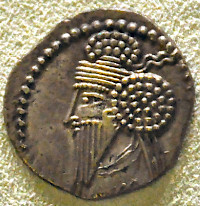Osroes I
Osroes I: Arsacid king of the Parthian Empire (r.105?-129; co-ruler).

In c.105 CE, the Parthian king Pacorus II died. He was succeeded by his brother Osroes I (a son of Vonones II and a Greek concubine), who inherited a conflict in the eastern part of the Parthian Empire, where Vologases III had revolted. Osroes would never be able to suppress this rebellion.
Nor was this his only military problem: he had to deal with the government of Armenia, a buffer state between the Parthian and Roman empires. The Armenian king was an Arsacid, i.e., a member of the Parthian dynasty, but was crowned by the Romans. This compromise had usually served to prevent war, but after c.110, Osroes had been forced to dethrone an Armenian leader, which was something no one had considered. The Roman emperor Trajan (r.98-117) decided to intervene.
The Graeco-Roman historian Cassius Dio summarizes what Parthian envoys, trying to avoid war, said:
When Trajan had set out against the Parthians and got as far as Athens, an embassy from Osroes met him, asking for peace and proffering gifts. ... At the same time he asked that Armenia be given to Parthamasiris, who was likewise a son of Pacorus, and requested that the diadem be sent to him; for he had deposed Axidares, he said, inasmuch as he had been satisfactory neither to the Romans nor to the Parthians.note
In other words, Osroes recognized that Rome was to crown the king of Armenia, and he had only removed a bad ruler (his nephew Axidares), so that a better man (his brother Parthamasiris) could occupy the throne. Trajan was not impressed. In 114, he invaded Armenia, accepted the surrender of Parthamasiris, and converted the kingdom into a Roman province.note
In 115, Osroes was unable to prevent the Romans from seizing the next two buffer states, Edessa and Nisibis,note and in 116, he had to face war inside the Parthian Empire itself. Babylon,note and Ctesiphonnote were lost to the Romans and Seleucia was captured too.note
However, rebellions broke out. In Armenia, the rebel leader was a man named Sanatruces; in the south, an Arsacid prince named Mithradates V, a relative of Osroes. The revolts prove the loyalty of the population to the Parthians. At the same time, the diasporic Jews revolted in Cyrenaica and on Cyprus, forcing Trajan to send troops to suppress them (more). Although Trajan overcame all troubles, he decided that it was better to give the Parthians a king of their own and appointed Parthamaspates, a son of Osroes.note
In 117, Trajan died. His successor Hadrian gave up the territories he had conquered. Osroes now could restore his power, and easily overcame Parthamaspates, who fled to the Romans. Hadrian appointed him as co-ruler of Osrhoene, residing as Edessa.
Although Osroes had managed to survive the Roman war, he was seriously weakened. Osrhoene and Characene had become independent; the eastern rebel Vologases III was now in control of Armenia. It is interesting that there are more coins of his eastern rival Vologases III, who was of course the main beneficiary of Trajan's attack. When Osroes died in 129, Mithradates V continued the civil war with Vologases.
Note
The chronology of the Arsacid kings of the Parthian Empire is less well-understood than, for example, the sequence of Seleucid and Ptolemaic kings or the emperors of Rome. This information is based on the researches by G.R.F. Assar, as published in "Iran under the Arsakids, 247 BC – AD 224/227" in: Numismatic Art of Persia (2011).